
While it may seem like making environmentally-friendly changes to your warehouse is costly, it can actually save money in the long-run. In this article, Kelly Friel, from industrial equipment and tool specialist Zoro, takes a look at some of the best areas to focus on.
In this difficult economic climate, it makes sense to consider ways to cut your business costs. But, many in the warehouse and logistics sector don’t realise that a great way of doing this is by focusing on making green changes to their facility. Eco-friendly alterations, such as motion-sensor lighting and solar panels, carry an upfront cost but pay for themselves in savings over the long-term.
Not only will you save funds, but you will be doing your bit for the planet, too. In a time when supply chains are responsible for 90% of the environmental impact behind a product (McKinsey), anything you can do to reduce this will make a great deal of difference. And, when customers get wind of the positive steps you’re making, you may also win some new business.
With this in mind, below I’ve highlighted a few eco-friendly improvements you can make that will help you save both money and the environment.
Motion sensitive LED lighting
Considering that the average warehouse in the UK is over 350,000 square feet in size (CBRE), it isn’t really a surprise to find that lighting is typically one of the biggest costs of maintaining a facility. But, it’s important to remember that not every inch of your warehouse needs to be illuminated at all times.
Fitting motion sensors to ensure only active areas are lit is a great idea. This way, your workforce can go about their business safely without being left in the dark, while you’re not paying for any power in unnecessary zones. Combining motion sensors with eco-friendly LED lighting also means that you will be using the minimum electricity possible from the grid, which is better for the environment.
Efficient warehouse layout and organisation
If your warehouse is laid out efficiently and your stock is organised in a way that facilitates easier picking and packing. With some careful planning, you can benefit from greater productivity (and better returns as a result), as well as keeping your environmental impact low.
When your warehouse layout is optimised and the stock you need more regularly is accessible, it should help to reduce travel through the space for your employees. This means that energy costs expended on the like of forklifts or lighting more of your facility will be reduced. Your workforce should be able to work more productively and you won’t be expending as much power.
Solar panels
Once upon a time, solar panels were an expensive proposition that only offered middling results. Now, however, the technology has come on leaps and bounds to the point that panels are highly efficient and available at affordable prices. Combine this with the large square footage and shade-free space available on the top of the typical warehouse, and it’s easy to see why solar panels are such an attractive proposition.
While there will always be an upfront installation cost, any panels installed will soon provide a return on investment as they severely reduce your reliance on grid electricity. You can also take heart from the fact that this does wonders for the environment, too.
Temperature control
Another big cost of maintaining a warehouse is controlling the temperature — when you’re trying to heat or cool such a big space, things can get expensive. In addition, powering a heating system for a large building significantly increases your environmental impact.
Thankfully, there are a number of things you can do to control the temperature without huge costs. For one, consider using more localised solutions for heating and cooling in fans and space heaters, rather than trying to cover every inch — staff will be able to work in the necessary areas while staying at a comfortable temperature. Painting your roof with reflective or light coloured paint is another way you can keep the interior cooler naturally, while adding insulation and resealing doors and windows is an effective way to keep the heat inside.
As you can see, there are quite a few ways you can both cut costs and make your warehouse more eco-friendly. It really is worth sitting down and thinking about some of the ways you might be able to improve your facility for the better.
